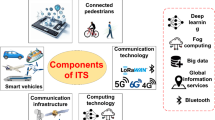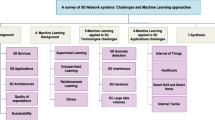Abstract
In this paper, the multiclass downlink capacity and the interference statistics of the sectors of a cigar-shaped microcells using wideband code-division multiple-access with soft handover mode are analyzed. The two-slope propagation model with log-normal shadowing is used in the analysis where a model of 8 cigar-shaped microcells is utilized. The performance of the downlink is studied for different [sector range R, standard deviation of the shadowing (\(\sigma _{1}\) and \(\sigma _{2})\) and propagation exponents (\(\text{ s}_{1}\) and \(\text{ s}_{2})\)]. It is found that increasing the sector range from 500 to 1,000 m will increase the sector downlink capacity. Also, it is found that increasing the value of the propagation parameters (\(\sigma _{1}\) and \(\sigma _{2})\) will reduce the downlink sector capacity. It is noticed that, the effect of changing the propagation exponent \(\text{ s}_{1}\) is null while increasing the propagation exponent \(\text{ s}_{2}\) will increase the downlink capacity.












Similar content being viewed by others
References
Holma, H., & Toskala, A. (2001). WCDMA for UMTS. In Radio access for third generation mobile communications. New York: Wiley.
Wong, D., & Lim, T. J. (1997). Soft handoffs in CDMA mobile systems. IEEE Personal Communication, 4(6), 6–17.
Radio Resource Control (RRC). (2002). Protocol specification, 3GPP TSG RAN 25.331 V. 5.2.0.
Viterbi, A. J., Viterbi, A. M., Gilhousen, K. S., & Zehavi, E. (1994). Soft handoff extends CDMA cell coverage and increases reverse link capacity. IEEE Journal on Selected Areas in Communication, 12(8), 1281–1288.
Mehailescu, C., Lagrange, X., & Godlewski, P. (1999). Soft handover analysis in downlink UMTS WCDMA system. In Proceedings of IEEE MoMuC, San Diego, CA, pp. 279–285.
Yang, X., Ghaheri-Niri, S., & Tafazolli, R. G. (2001). Downlink soft handover gain in CDMA cellular network with cross-correlated shadowing. In Proceedings of IEEE vehicular technology conference VTC, October 2001 (Vol. 1, pp. 276–280).
Zhang, D., Wei, G., & Zhu, J. (2002). Performance of hard and soft handover for CDMA system. In Proceedings of IEEE vehicular technology conference VTC, October 2002 (Vol. 2, pp. 1143–1147).
Chen, Y., & Cuthbert, L. (2002). Optimum size of soft handover zone in power controlled UMTS downlink systems. Electronics Letters, 38(2), 89–90.
Ahmed, B. T., Ramon, M. C., & Ariet, L. H. (2002). Capacity and interference statistics of highways W-CDMA cigar-shaped microcells (uplink analysis). IEEE Communications Letters, 6(5), 172–174.
Ahmed, B. T., Ramón, M. C., & Ariet, L. H. (2004). On the uplink capacity and interference statistics of cigar-shaped road microcells in over-ground train service. In 4th IASTED international multi-conference wireless and optical communications, Bnaff, Canada (pp. 109–114).
Ahmed, B. T., & Ramon, M. C. (2007). WCDMA multiservice uplink capacity of highways cigar-shaped microcells. EURASIP Journal on Wireless Communications and Networking, 84835, 8.
Zorzi, M. (1997). On the analytical computation of the interference statistics with application to the performance evaluation of mobile radio systems. IEEE Transactions on Communications, 45(1), 103–109.
Lee, C. C., & Steele, R. (1993). CDMA for city street microcells. In IEE colloquium on spread spectrum techniques for radio communication systems, pp. 3/1–3/10.
Dou, C., & Chang, Y. H. (2006). Class-based downlink capacity estimation of a WCDMA network in a multiservice context. Computer Communications Journal, 28, 1443–1455.
Malisuwan, S. (2006). Downlink capacity of mixed traffic in WCDMA mobile internet. International Journal of the Computer, the Internet and Management, 14(1), 1–7.
Alami, F. T., & Aknin, N. (2011). Capacity estimation of multi-service cellular network, dimensioning and planification network. International Journal on Computer Science and Engineering (IJCSE), 3(3), 1363–1368.
Ahmed, B. T., & Ramon, M. C. (2008). WCDMA downlink capacity of cigar-shaped microcells using soft hand-over with SIR based power control for over-ground train service. Computer Communications Journal, 31, 88–94.
Lopes, J. M. C. (2008). Performance analysis of UMTS/HSDPA/HSUPA at the cellular level. MSc. thesis.
Mohan, S., Kapoor, R., & Mohanty, B. (2011). Dual cell HSDPA application performance. In VTC Spring 2011, pp. 1–6.
Haider, F., Hepsaydir, E., & Binucci, N. (2011). Performance analysis of a live mobile broadband—HSDPA network. In VTC Spring, 2011, pp. 1–5.
Mehlführer, C., Caban, S., & Rupp, M. (2010). Measurement-based performance evaluation of MIMO HSDPA. IEEE Transactions on Vehicular Technology, 59(9), 4354–4367.
Puttone, J., Repo, I., Aho, K., Nihtil, T., Kurjenniem, J., Henttonen, T., et al. (2010). Non-regular network performance comparison between HSDPA and LTE. In 2010 5th international symposium on wireless and pervasive computing (ISWPC), pp. 568–572.
Tenorio, S., Exadaktylos, K., McWilliams, B., & Pézennec, Y. L. (2010). Mobile broadband field network performance with HSPA+. In 2010 European wireless conference, pp. 269–273.
Min, S., & Bertoni, H. L. (1998). Effect of path loss model on CDMA system design for highway microcells. In 48 th VTC, Ottawa, Canada, pp. 1009–1013.
Tsai, Y.-R., & Chang, J.-F. (1996). Feasibility of adding a personal communications network to an existing fixed-service microwave system. IEEE Transactions on Communications, 44(1), 76–83.
QUALCOMM. (2004). HSDPA for improved downlink data transfer.
Author information
Authors and Affiliations
Corresponding author
Rights and permissions
About this article
Cite this article
Ahmed, B.T. WCDMA Multiclass Downlink Capacity and Interference Statistics of Cigar-Shaped Microcells in Highways. Wireless Pers Commun 72, 941–956 (2013). https://doi.org/10.1007/s11277-013-1048-5
Published:
Issue Date:
DOI: https://doi.org/10.1007/s11277-013-1048-5




